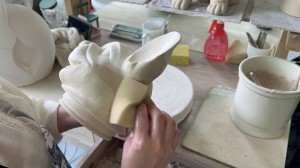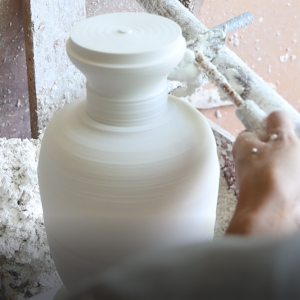In the field of handicrafts, both ceramic and porcelain frequently emerge as prominent material choices. However, these two materials are actually quite different. At DesignCrafts4U, our specialization lies in the creation of premium porcelain pieces, renowned for their elegance, long-lasting durability, and meticulous artistry. This begs the question: what’s the difference between porcelain and ceramic? Let us tell you the specific differences.

Firing Temperature & Material Composition:
The creation of porcelain involves the utilization of fine-particled kaolin clay, a key determinant of its superior qualities. This clay is subjected to remarkably high firing temperatures, reaching approximately 1270°C during the firing process. Such intense leads to a notably denser and more durable final product. Conversely, ceramics are fired at comparatively lower temperatures, typically ranging from 1080°C to 1100°C. The lower temperatures, while simplifying the manufacturing process, inherently compromise the final density and structural integrity of the material.
Shrinkage Rate: Precision Matters
In the context of producing intricate artware, the shrinkage rate during firing is a parameter of paramount importance. Porcelain exhibits a relatively high shrinkage rate, approximating 17%. This necessitates expert handling and a deep understanding of material behavior to achieve precise and predictable designs. Ceramics, on the other hand, demonstrate a considerably lower shrinkage rate, typically around 5%. While this facilitates easier production with fewer dimensional discrepancies, it comes at the expense of diminished density and ultimate durability. Artisans who specialize in porcelain have thus, generally, developed refined techniques to accurately predict dimensions of the final product.

Water Absorption & Durability
One of the defining characteristics of porcelain is its exceedingly low water absorption. It’s almost completely non-porous, preventing water from penetrating the material. This characteristic makes porcelain exceptionally well-suited for long-term use, even in environments characterized by high humidity, such as bathrooms or outdoor installations. Ceramics, owing to their coarser and more porous constitution, exhibit a comparatively higher rate of water absorption. Over prolonged periods, this absorbed moisture can potentially compromise the material's structural integrity, leading to cracking and degradation. For instance, ceramic vases left outdoors during winter are susceptible to damage from water absorption.
Hardness & Surface Strength
The elevated firing temperatures employed in the production of porcelain impart superior hardness and scratch resistance. This results in a smooth surface capable of withstanding considerable wear and tear. Porcelain items tend to retain their aesthetic appeal for extended durations, even with frequent use. In contrast, ceramics are typically more prone to chipping and scratching. Consequently, they are less suitable for applications involving frequent handling or exposure to abrasive forces. Therefore, while ceramics might be acceptable for decorative purposes, porcelain proves superior in applications requiring structural robustness.
Sound Test: A Clear Indicator
A simple yet telling method for distinguishing between porcelain and ceramic involves conducting a sound test. When struck, a porcelain object emits a clear, resonant, bell-like ring. Conversely, a ceramic object will generally produce a dull or hollow sound upon being struck.
Conclusion
While ceramic materials undoubtedly have their place in the field of handicrafts, porcelain distinguishes itself through its demonstrably superior quality, durability, and overall performance characteristics. This is precisely why DesignCrafts4U has dedicated over 13 years to specializing in porcelain craftsmanship, ensuring that our customers receive long-lasting, premium handicrafts distinguished by refined artistry and enduring value. We strive to make porcelain handicrafts meet the special requirements of each client, making a strong connection with our clients. We believe that by now you should have a better understanding of the differences between ceramic and porcelain!
Post time: Apr-29-2025







